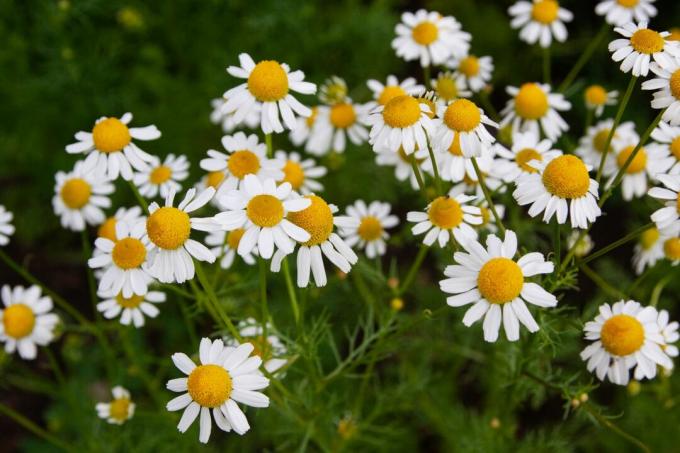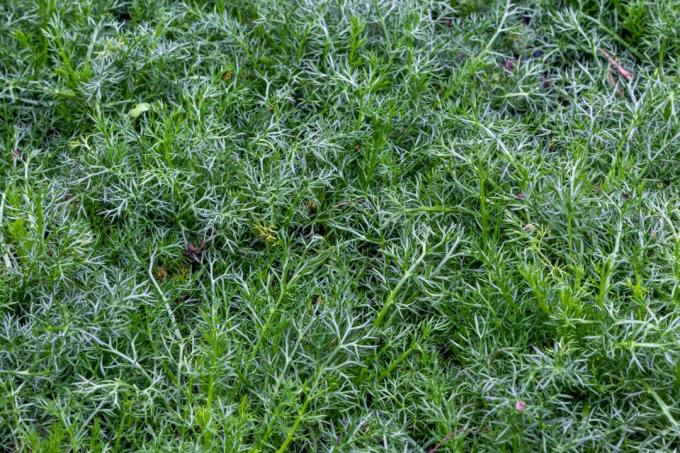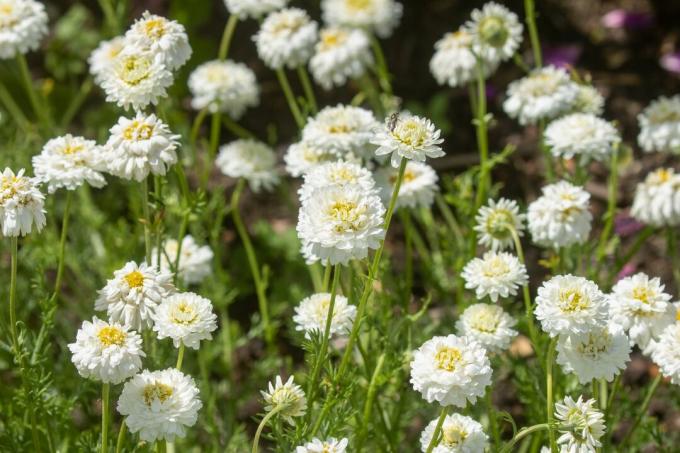Have you been dreaming of a fragrant lawn full of flowers for a long time? Then Roman chamomile is just right for you, because it forms dense, fragrant carpets of flowers.

Roman chamomile (Chamaemelum nobile) is an excellent lawn substitute, but can also be planted in beds as a bee-friendly ornamental plant. Here you can find out how it works and what you should consider when caring for it.
contents
- Roman chamomile: origin and properties
- Plant Roman chamomile: sowing, location and Co.
- Roman chamomile as a lawn substitute
- The right care
- Is Roman Chamomile Hardy?
- Use and effect of Roman chamomile
- Is Roman Chamomile Toxic?
Roman chamomile: origin and properties
Roman chamomile (Chamaemelum nobile), or Roman chamomile, belongs to the daisy family (Asteraceae). she sees the real chamomile (Matricaria chamomilla) confusingly similar and is also used as a medicinal and kitchen herb.
In addition, it is often used as a lawn substitute, because even occasional stepping on the chamomile lawn does not stop the growth of Roman chamomile. Due to the aromatic-smelling flowers and leaves, the lawn smells slightly of apples. Because of this use, Roman chamomile is also called lawn chamomile. It forms ground shoots, which quickly creates a dense carpet.
The perennial, herbaceous plant develops inflorescences with yellow tubular florets inside and white ray florets around the edges. The leaves are finely pinnate and have a pleasant scent. Growth heights of 20 to 30, sometimes 40 cm are reached. Roman chamomile is frequently visited by bees. Due to its flowering period from June to October, it still offers nectar in autumn.

Tip: Because of its aromatic scent, Roman chamomile is also called bath chamomile. It can be used excellently as a soothing bath additive.
What is the difference between Roman chamomile and real chamomile? The main difference between German chamomile and Roman chamomile is their lifespan. Roman chamomiles are perennial, so they sprout again after winter. Real chamomiles are annual. In addition, at around 30 cm, Roman chamomile is slightly smaller than real chamomile, which sometimes grows to 50 cm in height. More information about Risk of confusion with chamomile you will get in this article.
Plant Roman chamomile: sowing, location and Co.
In addition to being used as a lawn substitute, Roman chamomile can also simply be planted in the garden as an ornamental or useful plant. Like the real chamomile and the dyer's chamomile (Anthemis tinctoria) it is rather undemanding. It is best to sow Roman chamomile in a location that is bright or partially shaded. The soil must be loose and permeable, waterlogging must not occur. If the garden soil is quite loamy, it is advisable to mix in sand for better permeability. If, on the other hand, the subsoil is very poor in nutrients, a high-quality substrate such as ours can improve the site conditions Plantura organic universal soil be incorporated. Our soil also has a loose, permeable structure, but also provides important nutrients such as nitrogen and potassium. Loosen the soil and remove root residues or unwanted weeds.
Roman chamomile is brought into the garden by sowing or planting. Late spring and late summer are the best times to sow Roman chamomile. Moisten the soil beforehand and distribute the seed on it. The seeds should not or only slightly be covered with substrate, because they germinate in the light. At temperatures of 15 - 20 °C, germination can be expected after about two weeks. This should be watered regularly.

Roman chamomile as a lawn substitute
Since the Roman chamomile is quite tolerant of foot traffic - that is, it survives one or the other footprint without any problems - it is used as a lawn plant. It also forms ground shoots, through which the Roman chamomile spreads like a carpet. The pleasant scent that emanates from the flowers and leaves is another plus. However, the camomile lawn is not quite as robust as a grass lawn.
If you want to use Roman chamomile as a lawn substitute, you have to decide whether you want a white carpet of flowers or a flowerless green. In addition to the wild form, the following varieties are mainly considered:
‘Treneague’: Also called Roman carpet chamomile or English lawn chamomile. It does not form flowers, but only green foliage, is only about 10 cm high and spreads quickly with its shoots on the ground.

‘plenary’: This strain develops double buds, creating a blooming carpet. Unfortunately, however, this is not bee-friendly. In addition, it flowers sterile - so no seeds are formed.

In preparation for sowing the lawn, the soil should be freed from roots of previous plants. Heavy soils are loosened up with sand. The planting distance for the camomile lawn is 20 cm. In other words, there are about eleven specimens per square meter. You can be a little more generous when sowing, as not every seed will germinate. The young plants can be pricked out later. The location should be bright and sunny to create a dense and lush lawn. A cut is appropriate in the first late summer, because now the plants branch out and appear even denser. From the following year, the chamomile lawn can also be worked on with a lawnmower.

The right care
When it comes to caring for Roman chamomile, there is not much to consider because it is very frugal. It gets along well with dry soil and only needs to be watered during long periods of drought. If the Roman chamomile is cultivated as a lawn substitute, it can also be watered a little more regularly so that the plants grow lushly. However, under no circumstances should waterlogging occur.
Even fertilizing Roman chamomile is rarely necessary: a dose of slow-release fertilizer in spring is sufficient. In the case of particularly poor soils, the fertilizer can be incorporated in the first year before sowing. A suitable product is ours, for example Plantura organic universal fertilizer, which supplies the plants with important main nutrients thanks to its long-term effect over three months. It not only supports the growth of the chamomile, but also an active soil life.
A pruning promotes the branching of the plants. Depending on the variant, you should pay attention to the right time. Flowering varieties should not be cut before June, otherwise they will not flower at all. Flowerless varieties can also be cut earlier in the year. Late summer is the ideal time for pruning, also with regard to overwintering. Pruning is done generously to create a dense and highly branched carpet.
Is Roman Chamomile Hardy?
In our latitudes, Roman chamomile is hardy because it can withstand temperatures down to – 30 °C. Special precautions for hibernation are not necessary. If the Roman chamomile was planted in a pot, it should be placed close to the house wall in winter. Alternatively, you can wrap the pot in jute, because the soil in the pot freezes through more quickly due to the small volume.
Use and effect of Roman chamomile
In principle, Roman chamomile has similar healing effects to real chamomile. While the Roman chamomile has an aromatic, somewhat bitter taste, the aroma of the real chamomile is rather mild. The flowers of the Roman chamomile are mainly used, which are brewed as a tea, for example, and are said to help with digestive problems, nervous conditions and menstrual cramps. It contains essential oils such as chamazulene and nobilin. The flowers are harvested and dried as quickly and gently as possible to preserve them. Incidentally, dyer’s chamomile (Anthemis tinctoria).

Is Roman Chamomile Toxic?
As a medicinal plant and kitchen herb, Roman chamomile is not poisonous and can be planted without hesitation in gardens that are also accessible to children or pets. However, like many composite plants, Roman chamomile can also trigger contact dermatitis in allergy sufferers. Caution is also required when eating. Depending on age and general condition, the daily dose of about 6 g of the dried flowers should not be exceeded. If Roman chamomile is consumed regularly and in large quantities, symptoms of poisoning can occur - even in pets.
The effect and use of real and Roman chamomile hardly differ. Read how to here Harvesting and storing chamomile correctly.
